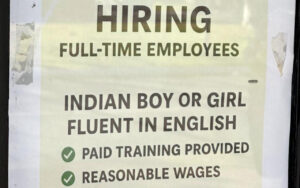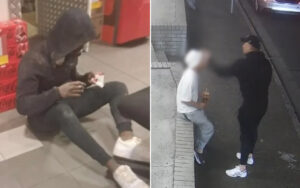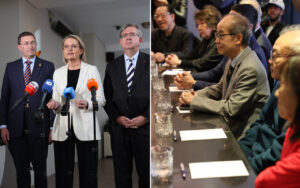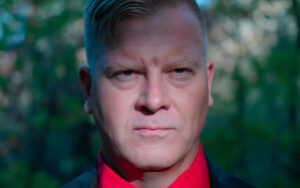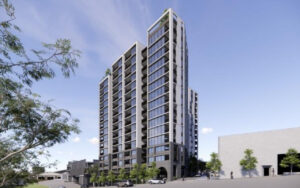Japan is a bit like the Germany of the East. Boundless potential that must be constrained by its enemies. The only reason it didn’t take over the global economy after WW2 is because Richard Nixon industrialised China and “international finance” created property bubbles that crashed Japan’s economy in the 1990s. After WW2, while the German people were being experimented on like guinea pigs by “American” psychologists, Japan was so culturally alien and impenetrable to the westerner that it was able to maintain more of its nationalist spirit. Therefore the same competent men who successfully attacked Pearl Harbor and conquered Asia were reinstalled to run the country and transform it into a leader of world industry.
Before the Second World War, one of the many things the Japanese would take from the West and improve upon was cinema. Along with America and Russia, Japan was perhaps the next most important innovator in the medium. Various big Hollywood films like Star Wars would take major influence and narratives from directors such as Akira Kurosawa. Clint Eastwood rose to fame in a series of westerns that were remakes of Japanese samurai films. Apart from genre pictures, Japan was pivotal in the formation of more high-brow poetic filmmaking. The writer of Taxi Driver, Paul Schrader, wrote the seminal book “Transcendental Style In Film”, which focused on Yasujiro Ozu, Robert Bresson and Carl Dreyer. Many classic films by master director Yasujiro Ozu (and others) are lost forever because of the firebombing of Tokyo and nuclear strikes on Japanese cities by America.

The oldest surviving Japanese photograph is from 1857. Ichiki Shirōi’s daguerreotype of greatly respected feudal lord Shimazu Nariakira. Daguerreotypes were made with a sheet of silver-plated copper polished to a mirror finish and treated with fumes that make its surface light-sensitive.
After WW2, Japan’s economic recovery started by making one to one copies of western products, knock-offs, but they would quickly develop and refine their own technology. One of the other western inventions Japan successfully built upon was the camera. Before WW2, Japan already had various camera manufacturers including Nikon, Olympus and Canon. They took the pre-war innovations made in Germany and Northern Europe and just ran with it. In the 1950s and 60s Japan was handed the keys to western markets and Pentax, Konica, Minolta, Mamiya and Yashica became global household names. Such classics as the Pentax Spotmatic, the first SLR with through the lens metering, were sold by the million. Movies such as Die Hard, Rising Sun, Blade Runner and Black Rain all in their own way expressed both American anxiety and admiration towards Japan’s rising economic power.
Apart from the quality mechanics of the cameras, Japan made beautiful lenses. Japanese precision lenses more than any other defined how we saw the world. Even the supposedly greatest of all cameras, the Swedish Hasselblad, has now dropped Carl Zeiss lenses in favour of Fujinon ones. It is no wonder the pre-iPhone cliché of the Japanese tourist constantly taking pictures exists, their nation was endlessly pumping out the latest and greatest camera technology. This would eventually extend to dominating the world of video cameras, televisions and video game systems with Sony replacing General Electric and Nintendo destroying Atari.
Comedian Patrice O’Neal talks about “hard consonants” on Comedy Central’s Tough Crowd
Behind the lens, before we had digital sensors and smartphone cameras, was perhaps the most mysterious, alchemical and beautiful aspect of the photographic process – film negative. Alongside America’s Kodak, the next powerhouse of film technology was Fuji and it would be an endless debate about which one was better. Kodak was actually a made up name, it meant nothing, they just hired a marketing company to construct a word that would be the most successful and so like comedians constructing a punchline, they went with hard consonant sounds. In reference to the “DC Sniper”, black comedian Patrice O’Neal used the punchline “Nigger in a Buick” instead of “Chevy” because of how it sounded with the “K” sound. When he said that joke on television, they actually bleeped out “Buick” instead of “nigger” so as not to defame the car manufacturer.
Conversely, Fuji was not a made up name because it did mean something. This film was named after Mount Fuji, an almost perfectly symmetrical active volcano that has inspired artists, poets and been the object of pilgrimage for centuries. Fuji created its own film stocks, with individual colour, grain structure and characteristics. Many of your favourite movies and photographs were produced using Fuji film. The current state of Fujifilm is in flux, subject to Globalist agendas of the fourth industrial revolution and the destruction of physical media. This has meant that despite growing demand (film is really “in” right now), rather than developing new film stocks, they have actually started to phase out existing classics like Superia X-Tra 400 and the magic, super-saturated Velvia and Provia slide films. The one shining light has been the innovation of Fuji Instax, an instant colour analogue photograph that has filled the void left by Polaroid. This has been embraced by young people and should be a signal that the consumer market desires physical analogue photography. We are human and we like physical things.
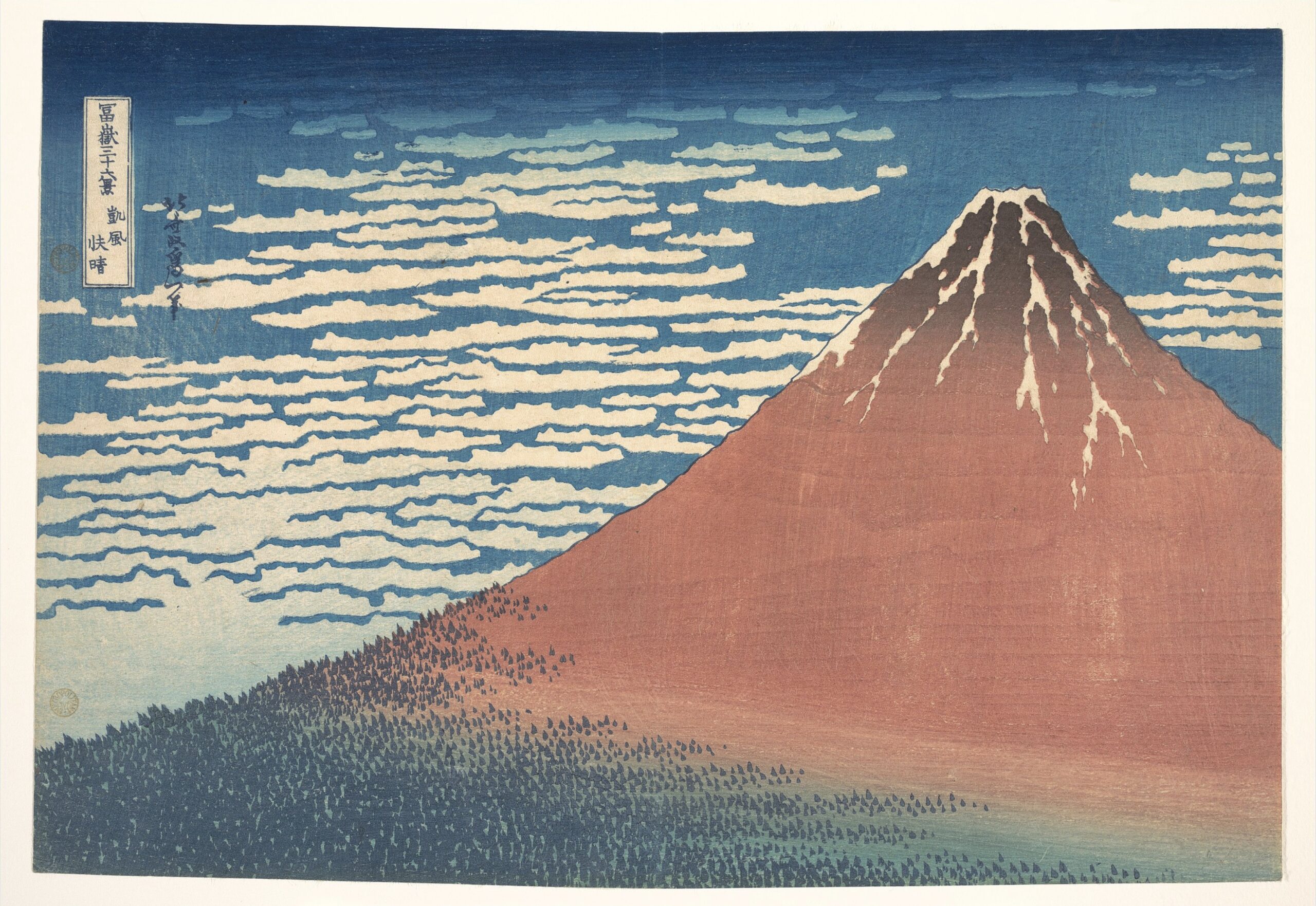
“Fine Wind, Clear Morning” also known as “Red Fuji” is a woodblock print by Japanese artist Hokusai (1760–1849), part of his Thirty-six Views of Mount Fuji series, dating from 1830 to 1832.
Film is magic. The various aesthetics of film are completely unmatched and only imitated in the digital era. But that imitation is of little meaning or value. The popularity of Instagram film-grain filters to turn harsh, ugly digital imagery into something palatable is testament to the timeless aesthetic of film. When HD video came to cinema, cinematographers hated it, having to apply heavy filtering to soften the sterile images. These computer chip sensors simply made women look ugly compared to the subtle diffusion and magical process of light kissing celluloid negative, being chemically brought to life in a chemical bath like a baptism. There are many philosophical and human layers to this as there are layers of emulsion. It is often said that labour is the source of all value. When something becomes easy, abundant and idiot proof – it’s no longer as valuable. And that’s what’s happened to photography. Not just with the smartphone but the DSLR that can take endless shots without the need for new film or lab processing. This magical human process cannot be authentically replaced by Instagram filters or digital software. The meaning and substance are very different.

Scene from the influential 1966 film “Blow-Up” directed by Michelangelo Antonioni. David Hemmings is using a Nikon F to photograph Veruschka von Lehndorff.
Want your photography to have intrinsic value and meaning? Start shooting on film. Beautiful models that get their photos taken all the time are far more impressed and curious about a photographer that uses a larger, solid, metallic art-deco-looking film camera. The winding of the film, mechanics and how it sounds makes these women double-take. If nothing else, it’s a conversation starter. An old-fashioned film camera looks like it comes straight out of a classic movie – when women were depicted at their most beautiful and desirable.. Models may not know the engineering and technical side behind one of these devices, but women have a keen sense for prestige, uniqueness and value. The fact that you are spending money on film and lab processing for every shot is a real investment in the human subject. Women love to be photographed, it’s very flattering to them, but someone capturing their image on film is something else. That’s right, shooting on film gets you ladies.
Norm Macdonald quickly explains how over-abundance and digital convenience has killed the value of photography
The Japanese are a serious and remarkable people. Despite partial American occupation since WW2, being subject to international financiers and associated agendas – they have remained ethnically homogeneous and nationalistic. Yes, issues of modernity and Globalism are always attempting to creep in and destroy what it is to be Japanese. “American” Blackstone has just invested half a billion into Japanese anime to probably turn it gay and African. But for the moment, this advanced place still strikes an eerie balance between its constant futurism and ancient tradition. Old ideas and aesthetics live somewhat harmoniously alongside modern culture. In some senses, because of their technological advancement, they have suffered some of the worst that modernity has to offer, children addicted to the internet and video games who won’t leave their room first manifested as a Japanese phenomena in the 1990s. They have also given birth to literally living in pods. So because Japan is further down the modernist pipeline, it’s only natural that some reactionary movements against the modern world will manifest there first. Thus despite being so technologically advanced, a strong sub-culture of shooting on film still exists in Japan and is growing among its youth.
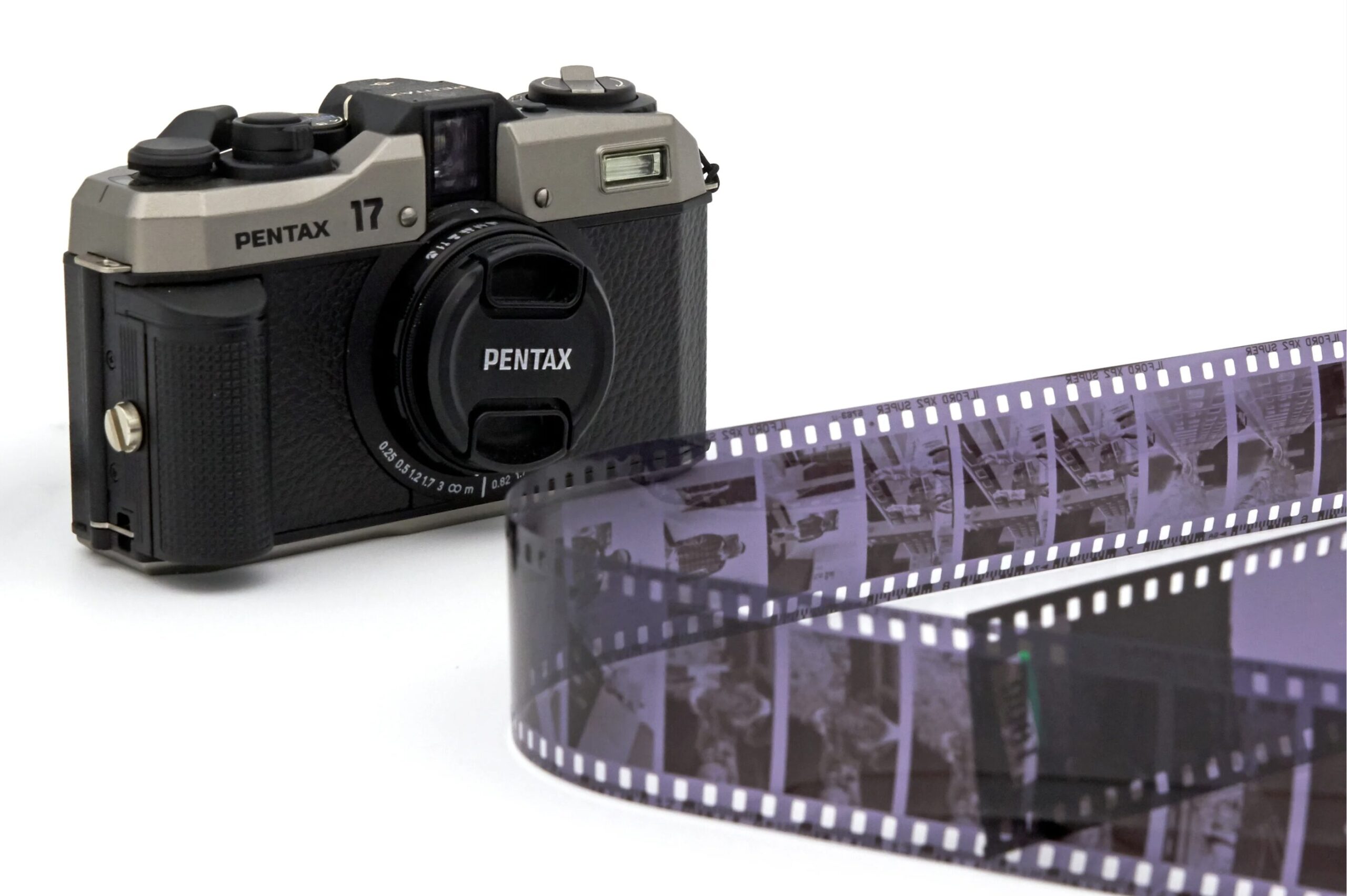
The new “Pentax 17” is the first new serious analogue film camera being made in decades
In comes Pentax. Pentax have made the bold step by creating the first entirely new film camera for many years. This was much harder than you think. It’s a bit like trying to land on the moon again, but being forced to only use techniques from before the 1960s. An intense amount of research and development has gone into this precision mechanical product in an industry that is otherwise 100% focused on digital technology. Old Japanese men were brought out of retirement to help engineer this ambitious project. Like retired samurai masters transferring wisdom to the next generation.
This isn’t just an old model dug-up and re-manufactured, it’s entirely new with a fresh point of view. The Pentax 17 has taken the unique position of being a vertical “half frame camera” in that it splits every normal sized photograph into 2, doubling the amount of shots you get from a roll of film. Buying and processing film has become more expensive, so doubling the amount of shots you get is convenient. Because it’s vertical rather than horizontal, it’s ideal for sharing on social media. This will be an injection of analogue alchemical material into the physical and digital realms, a revolt against the modern world. An aesthetic challenger in the cultural battlefields of social media as well as the brick and mortar art gallery. Also, the side by side vertical images will normally come back from the lab as diptychs, two images joined together, which has created a new analogue meme format and mode of expression.

Pentax 17 “diptych” shot with Kodak Gold 200 by Belgian photographer ivophoto
The reviews are in and very positive. The Pentax 17 is well-made, the lens is sharp and there are a few modern features that have made improvements on the point and shoot style film camera. Exposure settings are excellent. But the future of the Pentax 17 will not rest on its reviews, its fortunes will instead be decided by what young people do with it. It’s vertical, it provides the options for diptychs, it allows use of any 35mm film with all their unique characteristics to create images – black and white, slide film, infrared, t-grain – there are rare and out of production film-rolls kept in people’s freezers, so many creative choice to be made even before using the camera, the possibilities are endless. I already own other more professional film cameras, but I have purchased this new one to test it. It’s been very fun and its simplicity is liberating. I take it everywhere and everyone wants their photo taken by it (especially women).
Shooting on film sounds too complicated? Start with this new Pentax 17. It’s designed to be easy to use whilst being a quality camera at the same time. The perfect balance. You can shoot film in a contemporary style and make use of the new characteristics of this camera. Young digital natives making art with technology that’s been in existence since the 1800s – it will be fresh eyes upon something that older people have taken for granted, moved-on from and neglected. Move on boomers with your endless iPhone pictures of clouds – young people will naturally find new ways to use this timeless technology, they will have their own twist and try things not suggested in the manual. Teenagers have already embraced Fuji Instax but shooting on proper 35mm negatives will give the new generation way more creative options.
Pentax 17 “diptych” shot with Ilford Ilfocolour 400 Vintage Tone by photographer Jason Lau
There is at least one group of artistic nationalists in America already experimenting with this camera and the different film stocks available. I have been privy to some of the early results and they are wonderful. Expect to see this imagery soon in memes. Its really going to inject new life into how certain themes are depicted. Our propaganda will have a new substantial edge. And the broad right-wing position on this camera should be a complete embrace. The seeds are already there in the textural instincts of synthwave and fashwave, young people putting VHS filters and glitches on digital video to give it more character. But now its time to get more authentic and go on a true aesthetic journey. We must value superior analogue aesthetics.
When many are too lazy to even take a photo, instead of asking AI to conjure something from the void (cringe), we must go in the complete opposite direction. We cannot allow ourselves to atrophy into limp-wristed pod-dwellers. Film photography was never superseded – we were just offered a cheaper and more convenient alternative like an Indian delivering us lukewarm Uber Eats. We started to value images less and became lazier consoomers in the process. It should be no surprise that what we often describe as “the end of culture” or artistic decline has correlated with the adoption of digital and virtual over celluloid and physical. The medium is the message here.
If we make this product viable, it will open up a stream of new film options from manufacturers (both cameras and new film stocks) and change the course of artistic history. We must send a signal to the market that will otherwise just give us a 50th iPhone that reinforces their spiritual control-grid. If we are to take back the culture, it is our job to define aesthetics and what is beautiful. This starts with the substance that makes up an image, the colour, texture and PHYSICALITY that conjures more than just sterile depiction. The grain structures and deep mysteries of each film-stock are the artist’s palette to play with. One thing the dissident right prides itself on is having impulse control. It takes a sophisticated person to be patient and take photos not knowing what they look like until the lab has developed and scanned them. Its healthy delayed gratification. Are you even White?

Pentax 17 Diptych shot by Benoît Pinchon using Ilford HP5 Plus 400 black and white film
Britain’s Ilford has also produced one of the first entirely new colour film-stocks in many years aptly named Harman “Phoenix”. Developing a new film-stock from scratch is quite the undertaking and this new amber-tinged film is giving photographers some rose-coloured glasses to view the world, making reds pop like a shotgun. This bolsters Britain’s tradition of dominating black and white film with the legendary Ilford monochrome range still thriving. America’s Kodak has also revived slide or “positive” film with Ektachrome 100 allowing for more artistic experimentation. Pentax are bringing back film cameras from the dead so people don’t have to purchase second hand ones with no warranty. Pentax, Kodak, Ilford, Fuji, these companies are all defined by the nations that created them and the undertone of all this is national pride.
It’s the perfect time to photographically revolt against the modern digital world and pursue something meditative. This isn’t about living in a cave, but about being discerning. It’s time to be elitist. If we don’t differentiate ourselves artistically and start valuing things, appreciating moments without a digital screen, we are as bad as everyone else eating goyslop and using goytech. Invest in the very best quality aesthetics for yourself and your people. Document and illustrate the beauty of our world in the most substantial and creative way possible.
Buy the Pentax 17 from Amazon and help support The Noticer (affiliate link)

